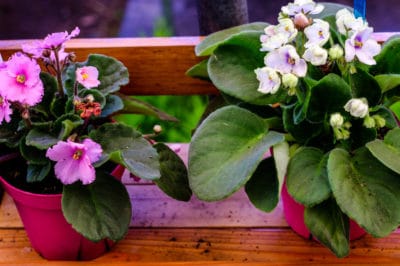Start With the Light
If there is a single hard and fast rule where African violets are concerned, it’s providing the right amount and kind of light. In order to be healthy and bloom, these plants need 14 to 16 hours of bright indirect light every day. They must also have eight hours of dark, which triggers flowering. A window that faces west or south with a translucent shade is ideal.
Proper Potting Soil
African violets like soil that is just a little on the acid side, with a pH of 5.8 to 6.2. It must drain well, as the plants are very sensitive to soggy soil. Commercial potting soil specifically mixed for African violets is a good choice. You can also make your own. Mix equal parts of peat moss, perlite or vermiculite and builder’s sand. Pasteurize by heating to 180°F (82°C) and holding it there for 30 minutes.
Choosing Plants
African violets belong to one of two main groups: rosettes and trailing plants.
Rosette African Violets:
- Grow their leaves in a circular pattern outward from the center.
- Have a single crown.
- Cluster blooms in the center of the rosette.
Trailing African Violets:
- Have multiple stems of crowns growing from the center of the plant.
- Grow sideways in a cascading habit.
Humidity Matters
African violets come from the humid tropics. Ideally, they like a humidity of about 50 to 60 percent. Place the pots on shallow trays with a single layer of pebbles and fill the trays with water. Group plants closely together. Mist several times a day (but not when the plant is in bright sunlight as it can damage leaves). Always use room temperature water for misting.
Water Correctly
African violets like moist soil, but soggy soil encourages root rot and can kill the plants. It’s better to water from the bottom, by placing the pot in a shallow bowl of room temperature water for about 30 minutes; drain completely. Rainwater or filtered water is a better choice than tap water because of chlorine and mineral salts.
Fertilize Regularly
Commercial African violet food is the best choice to keep the plants healthy and blooming well. The standard formula is 14-12-14 NPK. Most experts recommend using fully water-soluble fertilizer so you can water and fertilize at the same time. Follow instructions carefully; it’s better to fertilize more often with less than to risk burning or possibly killing a plant.
